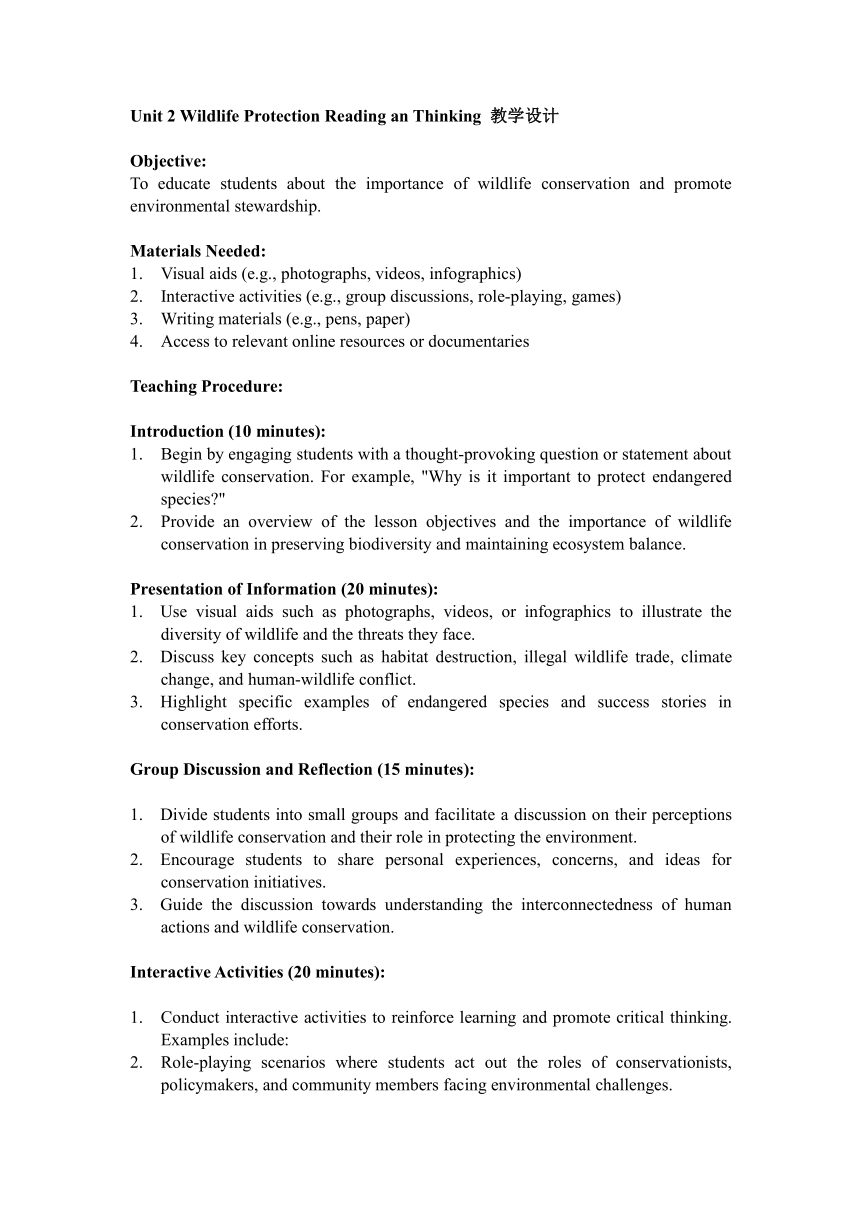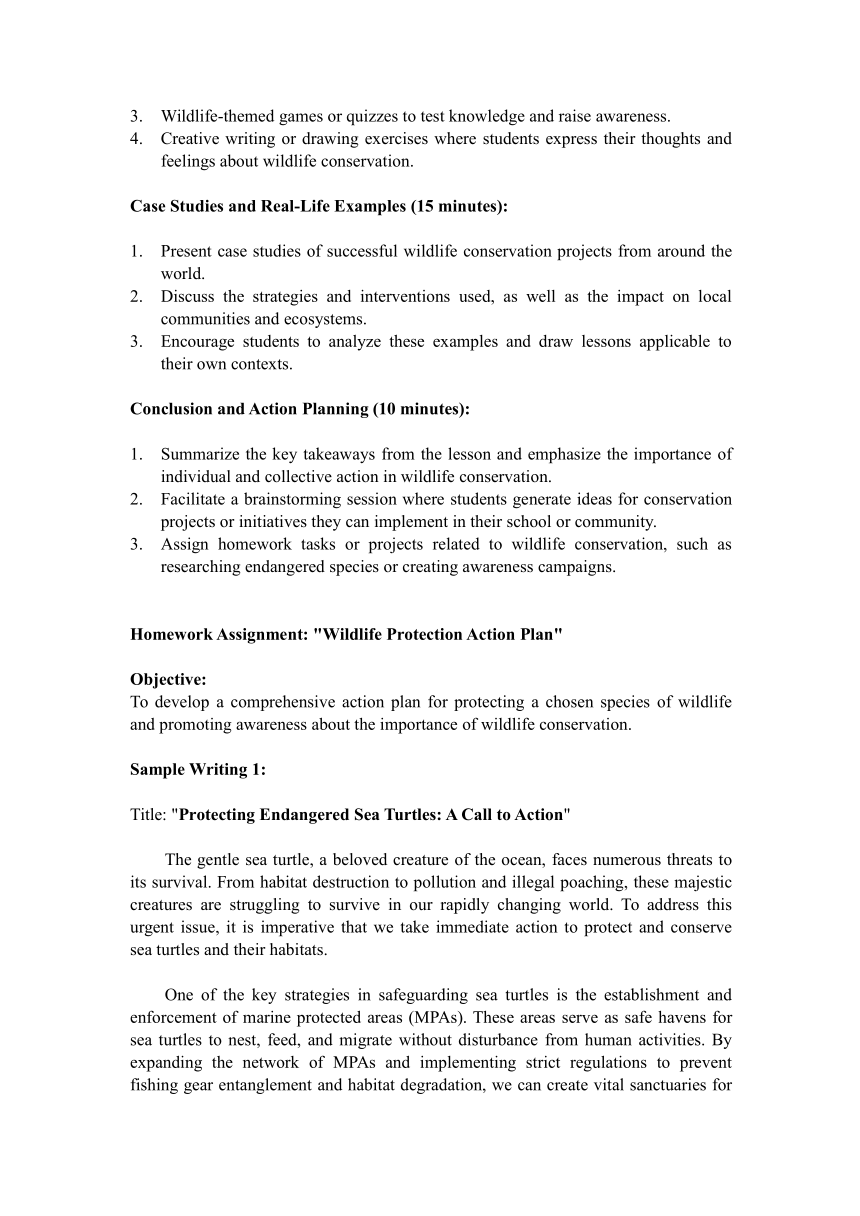人教版(2019)必修 第二册Unit 2 Wildlife protection Reading and Thinking 教学设计
文档属性
| 名称 | 人教版(2019)必修 第二册Unit 2 Wildlife protection Reading and Thinking 教学设计 |  | |
| 格式 | docx | ||
| 文件大小 | 19.3KB | ||
| 资源类型 | 教案 | ||
| 版本资源 | 人教版(2019) | ||
| 科目 | 英语 | ||
| 更新时间 | 2024-03-17 23:08:06 | ||
图片预览


文档简介
Unit 2 Wildlife Protection Reading an Thinking 教学设计
Objective:
To educate students about the importance of wildlife conservation and promote environmental stewardship.
Materials Needed:
Visual aids (e.g., photographs, videos, infographics)
Interactive activities (e.g., group discussions, role-playing, games)
Writing materials (e.g., pens, paper)
Access to relevant online resources or documentaries
Teaching Procedure:
Introduction (10 minutes):
Begin by engaging students with a thought-provoking question or statement about wildlife conservation. For example, "Why is it important to protect endangered species "
Provide an overview of the lesson objectives and the importance of wildlife conservation in preserving biodiversity and maintaining ecosystem balance.
Presentation of Information (20 minutes):
Use visual aids such as photographs, videos, or infographics to illustrate the diversity of wildlife and the threats they face.
Discuss key concepts such as habitat destruction, illegal wildlife trade, climate change, and human-wildlife conflict.
Highlight specific examples of endangered species and success stories in conservation efforts.
Group Discussion and Reflection (15 minutes):
Divide students into small groups and facilitate a discussion on their perceptions of wildlife conservation and their role in protecting the environment.
Encourage students to share personal experiences, concerns, and ideas for conservation initiatives.
Guide the discussion towards understanding the interconnectedness of human actions and wildlife conservation.
Interactive Activities (20 minutes):
Conduct interactive activities to reinforce learning and promote critical thinking. Examples include:
Role-playing scenarios where students act out the roles of conservationists, policymakers, and community members facing environmental challenges.
Wildlife-themed games or quizzes to test knowledge and raise awareness.
Creative writing or drawing exercises where students express their thoughts and feelings about wildlife conservation.
Case Studies and Real-Life Examples (15 minutes):
Present case studies of successful wildlife conservation projects from around the world.
Discuss the strategies and interventions used, as well as the impact on local communities and ecosystems.
Encourage students to analyze these examples and draw lessons applicable to their own contexts.
Conclusion and Action Planning (10 minutes):
Summarize the key takeaways from the lesson and emphasize the importance of individual and collective action in wildlife conservation.
Facilitate a brainstorming session where students generate ideas for conservation projects or initiatives they can implement in their school or community.
Assign homework tasks or projects related to wildlife conservation, such as researching endangered species or creating awareness campaigns.
Homework Assignment: "Wildlife Protection Action Plan"
Objective:
To develop a comprehensive action plan for protecting a chosen species of wildlife and promoting awareness about the importance of wildlife conservation.
Sample Writing 1:
Title: "Protecting Endangered Sea Turtles: A Call to Action"
The gentle sea turtle, a beloved creature of the ocean, faces numerous threats to its survival. From habitat destruction to pollution and illegal poaching, these majestic creatures are struggling to survive in our rapidly changing world. To address this urgent issue, it is imperative that we take immediate action to protect and conserve sea turtles and their habitats.
One of the key strategies in safeguarding sea turtles is the establishment and enforcement of marine protected areas (MPAs). These areas serve as safe havens for sea turtles to nest, feed, and migrate without disturbance from human activities. By expanding the network of MPAs and implementing strict regulations to prevent fishing gear entanglement and habitat degradation, we can create vital sanctuaries for these vulnerable marine species.
Furthermore, public awareness and education play a crucial role in promoting sea turtle conservation. Through educational campaigns, community outreach programs, and ecotourism initiatives, we can raise awareness about the importance of preserving sea turtle habitats and the impact of human actions on their survival. By fostering a sense of stewardship and responsibility towards these magnificent creatures, we can inspire individuals and communities to take proactive steps to protect sea turtles and their marine ecosystems.
In conclusion, the protection of endangered sea turtles requires a concerted effort from governments, conservation organizations, and the public. By implementing conservation measures such as marine protected areas and raising awareness through education and outreach, we can ensure a brighter future for these iconic marine species.
Sample Writing 2:
Title: "Safeguarding the Last Lions: Conservation Efforts in Africa"
The iconic African lion, once a symbol of strength and majesty across the savannas of Africa, is now facing unprecedented threats to its survival. Habitat loss, human-wildlife conflict, poaching, and disease have contributed to a sharp decline in lion populations, pushing these apex predators towards the brink of extinction. In response to this crisis, conservation organizations and governments are implementing innovative strategies to protect and conserve the last remaining lions in Africa.
One of the key initiatives in lion conservation is the establishment of protected areas and wildlife reserves where lions can roam freely without the threat of habitat destruction or human encroachment. These protected areas serve as important refuges for lions and other wildlife, providing them with the space and resources they need to thrive in their natural habitats.
In addition to habitat protection, community-based conservation programs are also playing a vital role in lion conservation efforts. By engaging local communities in conservation initiatives, providing alternative livelihoods, and promoting coexistence between people and wildlife, these programs are helping to reduce human-wildlife conflict and mitigate the impact of human activities on lion populations.
Furthermore, advances in technology, such as GPS tracking collars and remote sensing, are enabling researchers and conservationists to monitor lion populations more effectively and implement targeted conservation interventions. By using science-based approaches and collaborative partnerships, we can ensure the long-term survival of lions and safeguard Africa's rich biodiversity for future generations.
In conclusion, the conservation of African lions requires a multifaceted approach that addresses the complex challenges facing these magnificent creatures. Through habitat protection, community engagement, and technological innovation, we can work together to secure a future where lions continue to roam the African savannas as symbols of strength, resilience, and natural beauty.
Objective:
To educate students about the importance of wildlife conservation and promote environmental stewardship.
Materials Needed:
Visual aids (e.g., photographs, videos, infographics)
Interactive activities (e.g., group discussions, role-playing, games)
Writing materials (e.g., pens, paper)
Access to relevant online resources or documentaries
Teaching Procedure:
Introduction (10 minutes):
Begin by engaging students with a thought-provoking question or statement about wildlife conservation. For example, "Why is it important to protect endangered species "
Provide an overview of the lesson objectives and the importance of wildlife conservation in preserving biodiversity and maintaining ecosystem balance.
Presentation of Information (20 minutes):
Use visual aids such as photographs, videos, or infographics to illustrate the diversity of wildlife and the threats they face.
Discuss key concepts such as habitat destruction, illegal wildlife trade, climate change, and human-wildlife conflict.
Highlight specific examples of endangered species and success stories in conservation efforts.
Group Discussion and Reflection (15 minutes):
Divide students into small groups and facilitate a discussion on their perceptions of wildlife conservation and their role in protecting the environment.
Encourage students to share personal experiences, concerns, and ideas for conservation initiatives.
Guide the discussion towards understanding the interconnectedness of human actions and wildlife conservation.
Interactive Activities (20 minutes):
Conduct interactive activities to reinforce learning and promote critical thinking. Examples include:
Role-playing scenarios where students act out the roles of conservationists, policymakers, and community members facing environmental challenges.
Wildlife-themed games or quizzes to test knowledge and raise awareness.
Creative writing or drawing exercises where students express their thoughts and feelings about wildlife conservation.
Case Studies and Real-Life Examples (15 minutes):
Present case studies of successful wildlife conservation projects from around the world.
Discuss the strategies and interventions used, as well as the impact on local communities and ecosystems.
Encourage students to analyze these examples and draw lessons applicable to their own contexts.
Conclusion and Action Planning (10 minutes):
Summarize the key takeaways from the lesson and emphasize the importance of individual and collective action in wildlife conservation.
Facilitate a brainstorming session where students generate ideas for conservation projects or initiatives they can implement in their school or community.
Assign homework tasks or projects related to wildlife conservation, such as researching endangered species or creating awareness campaigns.
Homework Assignment: "Wildlife Protection Action Plan"
Objective:
To develop a comprehensive action plan for protecting a chosen species of wildlife and promoting awareness about the importance of wildlife conservation.
Sample Writing 1:
Title: "Protecting Endangered Sea Turtles: A Call to Action"
The gentle sea turtle, a beloved creature of the ocean, faces numerous threats to its survival. From habitat destruction to pollution and illegal poaching, these majestic creatures are struggling to survive in our rapidly changing world. To address this urgent issue, it is imperative that we take immediate action to protect and conserve sea turtles and their habitats.
One of the key strategies in safeguarding sea turtles is the establishment and enforcement of marine protected areas (MPAs). These areas serve as safe havens for sea turtles to nest, feed, and migrate without disturbance from human activities. By expanding the network of MPAs and implementing strict regulations to prevent fishing gear entanglement and habitat degradation, we can create vital sanctuaries for these vulnerable marine species.
Furthermore, public awareness and education play a crucial role in promoting sea turtle conservation. Through educational campaigns, community outreach programs, and ecotourism initiatives, we can raise awareness about the importance of preserving sea turtle habitats and the impact of human actions on their survival. By fostering a sense of stewardship and responsibility towards these magnificent creatures, we can inspire individuals and communities to take proactive steps to protect sea turtles and their marine ecosystems.
In conclusion, the protection of endangered sea turtles requires a concerted effort from governments, conservation organizations, and the public. By implementing conservation measures such as marine protected areas and raising awareness through education and outreach, we can ensure a brighter future for these iconic marine species.
Sample Writing 2:
Title: "Safeguarding the Last Lions: Conservation Efforts in Africa"
The iconic African lion, once a symbol of strength and majesty across the savannas of Africa, is now facing unprecedented threats to its survival. Habitat loss, human-wildlife conflict, poaching, and disease have contributed to a sharp decline in lion populations, pushing these apex predators towards the brink of extinction. In response to this crisis, conservation organizations and governments are implementing innovative strategies to protect and conserve the last remaining lions in Africa.
One of the key initiatives in lion conservation is the establishment of protected areas and wildlife reserves where lions can roam freely without the threat of habitat destruction or human encroachment. These protected areas serve as important refuges for lions and other wildlife, providing them with the space and resources they need to thrive in their natural habitats.
In addition to habitat protection, community-based conservation programs are also playing a vital role in lion conservation efforts. By engaging local communities in conservation initiatives, providing alternative livelihoods, and promoting coexistence between people and wildlife, these programs are helping to reduce human-wildlife conflict and mitigate the impact of human activities on lion populations.
Furthermore, advances in technology, such as GPS tracking collars and remote sensing, are enabling researchers and conservationists to monitor lion populations more effectively and implement targeted conservation interventions. By using science-based approaches and collaborative partnerships, we can ensure the long-term survival of lions and safeguard Africa's rich biodiversity for future generations.
In conclusion, the conservation of African lions requires a multifaceted approach that addresses the complex challenges facing these magnificent creatures. Through habitat protection, community engagement, and technological innovation, we can work together to secure a future where lions continue to roam the African savannas as symbols of strength, resilience, and natural beauty.
